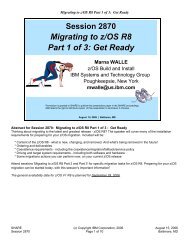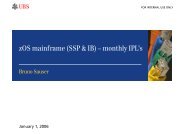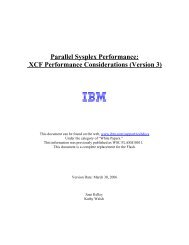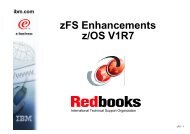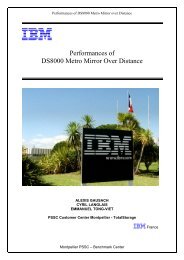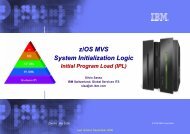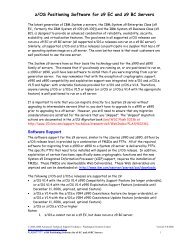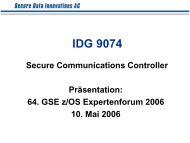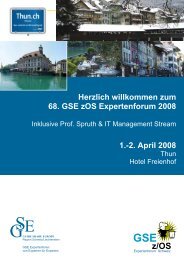Hot Topics - Messmer The Brain House
Hot Topics - Messmer The Brain House
Hot Topics - Messmer The Brain House
Create successful ePaper yourself
Turn your PDF publications into a flip-book with our unique Google optimized e-Paper software.
of smaller data sets onto a single tape<br />
volume. Do you have any development<br />
plans in the works to allow more data sets<br />
to be written on a single tape?<br />
Just Curious,<br />
Mr. Quartercentury<br />
Dear Mr. Quartercentury,<br />
We have just the thing for your capacity<br />
concerns. We have a new enhancement<br />
in V1R7 of DFSMShsm that allows us to<br />
write significantly more data sets per tape.<br />
We used to be able to describe<br />
330,000 data sets in a DFSMShsm tape<br />
volume tape table of contents (TTOC).<br />
Now in V1R7, DFSMShsm can describe<br />
up to 1,060,000 data sets in a tape volume<br />
TTOC (wow!). <strong>The</strong>re is some preparation<br />
on your part if you want to use this new<br />
EXTENDEDTTOC enhancement. Just<br />
follow the steps below and you will be on<br />
your way:<br />
1. Ensure that all hosts in an<br />
HSMplex are at z/OS DFSMS<br />
V1R7.<br />
2. Define your offline control data<br />
set (OCDS) with a maximum<br />
record size of 6144 bytes,<br />
as described in z/OS V1R7<br />
DFSMShsm Implementation and<br />
Customization Guide.<br />
3. Enter the SETSYS command<br />
with optional parameter<br />
EXTENDEDTTOC(Y) to enable<br />
the support.<br />
It is that easy. Remember, we might not<br />
write over 1 million data sets per tape if<br />
we do indeed fill the tape up with data.<br />
Oh, by the way, don’t feel bad about<br />
remembering the 3480s. I still have punch<br />
cards scattered around my office and a<br />
slide rule by my PC!<br />
Thanks,<br />
IBMer<br />
Hello IBM,<br />
I am head of architecture at ISV123.<br />
We specialize in developing data mining<br />
and reporting applications for the z/OS<br />
platform. Recently, we have had many<br />
customer requests for an application to<br />
data mine DFSMShsm’s migrated data and<br />
provide information back to the end-user.<br />
Currently, we are in the process of designing<br />
a new application. We have noticed that we<br />
cannot determine the logical record length<br />
(LRECL) of any migrated data sets without<br />
50 February 2006 z/OS HOT TOPICS Newsletter, Issue 14<br />
recalling the data set. This is very cost<br />
prohibitive for us and cumbersome. Is there<br />
something we are missing here?<br />
Thanks,<br />
Dr. Dataextract<br />
ISV123 Lead Developer<br />
Greetings, Dr. Dataextract!<br />
DFSMShsm has a solution to your<br />
request beginning in z/OS V1R7. We<br />
have added a LRECL field in the MCD<br />
record for all VSAM and non-VSAM<br />
migrated data sets. In addition to the<br />
LRECL field, you might also be interested<br />
in another bit we added. It indicates<br />
whether the data set was empty at the<br />
time of migration. We have enhanced<br />
the DFSMShsm LIST MCDS command<br />
with the new option SELECT(EMPTY)<br />
to allow easier identification of all<br />
empty migrated data sets. You can use<br />
the IDCAMS DCOLLECT utility with<br />
MIGRATEDDATA option to retrieve this<br />
newly recorded information from the<br />
MCDS, along with many other data set<br />
characteristics. Keep in mind that this<br />
information is only available on those data<br />
sets that have been migrated using a z/OS<br />
DFSMShsm V1R7 system or higher.<br />
Happy Mining!<br />
IBMer<br />
Hello IBM,<br />
Currently, I create an aggregate backup<br />
and recovery support (ABARS) aggregate<br />
with an ALLOCATE statement in the<br />
selection data set for all my ICF user<br />
catalogs and GDG base definitions. I call<br />
this aggregate my “baseline” aggregate<br />
because it defines the required ICF user<br />
catalogs (and the associated aliases), and<br />
the GDG base definitions. <strong>The</strong>se need to<br />
be in place before I use the ARECOVER<br />
command to recover the remaining<br />
aggregates that contain critical application<br />
data. In this aggregate, I would prefer not<br />
to actually back up any data, but currently<br />
I’m required to include at least one data<br />
set in the aggregate or the ABACKUP<br />
command fails. Is there anything you<br />
can do to eliminate the need to have an<br />
INCLUDE statement in the selection data<br />
set for an aggregate group?<br />
Thanks,<br />
Ms. Noinclude<br />
Hello Ms. Noinclude,<br />
In z/OS V1R7, DFSMShsm has<br />
removed the requirement that there must<br />
be at least one INCLUDE statement in<br />
selection data set. This allows installations<br />
to define aggregates with only ALLOCATE<br />
or ACCOMPANY statements. This<br />
enhancement makes it easier for installations<br />
to define a “baseline” aggregate. <strong>The</strong><br />
baseline aggregate defines the ICF user<br />
catalog environment and predefines the GDG<br />
base definitions prior to the restoration of<br />
application data.<br />
Let us know if you have any more questions.<br />
Thanks,<br />
IBMer<br />
Hello,<br />
I have some connected sets that never<br />
get recycled even though the percentage<br />
of valid data on the connected set is<br />
below the PERCENTVALID specified on<br />
the generic RECYCLE command. In my<br />
shop we have a limited number of tape<br />
cartridges and we need to return tapes to<br />
scratch as quickly as possible. Can anyone<br />
tell me why DFSMShsm does not recycle<br />
these connected sets?<br />
Thanks,<br />
Mr. Connected<br />
Hello Mr. Connected,<br />
<strong>The</strong> algorithm used by the generic<br />
RECYCLE command calculates the<br />
PERCENTVALID criteria to decide if a<br />
connected set is eligible for recycle. In<br />
order for the connected set to get recycled,<br />
two criteria have to be met:<br />
• <strong>The</strong> first volume in the connected<br />
set must meet the PERCENTVALID<br />
threshold.<br />
• <strong>The</strong> connected set as a whole must<br />
meet the PERCENTVALID threshold.<br />
Most likely, your connected set does not<br />
get recycled because too much valid<br />
data exists on the first volume in the<br />
connected set. This prevents recycle<br />
from even looking at the total amount<br />
of valid data in the entire connected set.<br />
DFSMShsm V1R7 provides you with<br />
a new option that allows you to decide<br />
if the first volume in the connected<br />
set must meet the PERCENTVALID<br />
threshold. A new CHECKFIRST(Y | N)<br />
keyword has been added to the RECYCLE<br />
command. <strong>The</strong> CHECKFIRST keyword<br />
indicates to RECYCLE processing<br />
whether or not to check whether the first




